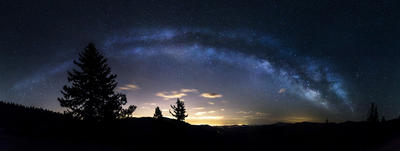Ah, as of now, my setup for this picture was:
- Canon T3i
- 18-55 Kit Lens
- Manfrotto 055XPROB + 701HDV
- A place without much light pollution (Leadville, CO) <---- SOOO IMPORTANT
Here's shameless self-promotion, however, a very good example:
So, here's the tutorial:
You need:
- Camera with M mode (obviously) and can shoot RAW or NEF for you Nikon shmucks
- Tripod
- PTGui Pro
- Lightroom
- OPTIONAL - Photoshop, to clean stuff up if needed
1. Go out where the stars are visible, find the milky way. Set up the shot horizontally on your tripod, make sure you're in RAW mode. Set your settings to ISO 1600, f/3.5, shutter 30 sec, WB 3700-3900 ish. (feel free to change these settings to accomodate your camera, this is with the kit lens and it has worked best for me)
2. Take as many shots as you want for the panorama. I do 12-16 shots per panorama. To do it, I start on the milky way, dead center, take the shot, then I pan the shot upward to a point where I think that the top 40% of the first shot is now the bottom 40% of the second/shot above the first. I do this once more, so I now have three photos, each one vertically above the last. I return the camera to the horizon, pan left until the shot is mostly new (you HAVE to make sure that the shots overlap, though, so you'll be able to stitch them in post). Then I repeat the vertical shooting process. When I'm done, I'll have 12 pictures, 4 long and 3 tall. You can choose to shoot 4 more along the bottom with a longer exposure or higher ISO, etc. so that you have a lighter foreground that you can layer in with Photoshop, it's up to you.
3. Bring your photos into Lightroom, fully adjust one of the photos (ideally the shot with the milky way in it, that's most important) to your liking, then apply those changes to ALL of the other photos in the panorama, feel free to make minor adjustments to each shot, but keep the settings generally similar. You MUST use the "Profile Corrections" tool to eliminate warping and vignetting from your lens so that you have a cleaner stitch to finish. Export the images to JPEG.
4. Open PTGui and load the images, it'll automatically try to align them, but it wont be able to because it is at night and obvious similarities are not findable. You'll have to set control points (points that are the same in to overlapping images) manually. This means you have to find parts of one image that also show in the image next to/above it, and you'll manually select each point one by one in both pictures until you have about 15, then you can move on to the next picture. You have to do this with every touching picture. So if you're setting control points with the bottom right picture, you'll have to set them with the above image and the image to the left. Once you've set all the points, it will take a LONG time, you can preview it in the preview window. and make adjustments/set and change control points accordingly.
4. Export from PTGui and you can choose to open in Photoshop and add a lighter foreground, or you can bring it back into Lightroom and adjust the image a little more to your liking.
5. You should be done! Upload and you now have total bragging rights about the badass star panorama you just made!
- Camera with M mode (obviously) and can shoot RAW or NEF for you Nikon shmucks
- Tripod
- PTGui Pro
- Lightroom
- OPTIONAL - Photoshop, to clean stuff up if needed
1. Go out where the stars are visible, find the milky way. Set up the shot horizontally on your tripod, make sure you're in RAW mode. Set your settings to ISO 1600, f/3.5, shutter 30 sec, WB 3700-3900 ish. (feel free to change these settings to accomodate your camera, this is with the kit lens and it has worked best for me)
2. Take as many shots as you want for the panorama. I do 12-16 shots per panorama. To do it, I start on the milky way, dead center, take the shot, then I pan the shot upward to a point where I think that the top 40% of the first shot is now the bottom 40% of the second/shot above the first. I do this once more, so I now have three photos, each one vertically above the last. I return the camera to the horizon, pan left until the shot is mostly new (you HAVE to make sure that the shots overlap, though, so you'll be able to stitch them in post). Then I repeat the vertical shooting process. When I'm done, I'll have 12 pictures, 4 long and 3 tall. You can choose to shoot 4 more along the bottom with a longer exposure or higher ISO, etc. so that you have a lighter foreground that you can layer in with Photoshop, it's up to you.
3. Bring your photos into Lightroom, fully adjust one of the photos (ideally the shot with the milky way in it, that's most important) to your liking, then apply those changes to ALL of the other photos in the panorama, feel free to make minor adjustments to each shot, but keep the settings generally similar. You MUST use the "Profile Corrections" tool to eliminate warping and vignetting from your lens so that you have a cleaner stitch to finish. Export the images to JPEG.
4. Open PTGui and load the images, it'll automatically try to align them, but it wont be able to because it is at night and obvious similarities are not findable. You'll have to set control points (points that are the same in to overlapping images) manually. This means you have to find parts of one image that also show in the image next to/above it, and you'll manually select each point one by one in both pictures until you have about 15, then you can move on to the next picture. You have to do this with every touching picture. So if you're setting control points with the bottom right picture, you'll have to set them with the above image and the image to the left. Once you've set all the points, it will take a LONG time, you can preview it in the preview window. and make adjustments/set and change control points accordingly.
4. Export from PTGui and you can choose to open in Photoshop and add a lighter foreground, or you can bring it back into Lightroom and adjust the image a little more to your liking.
5. You should be done! Upload and you now have total bragging rights about the badass star panorama you just made!
Side notes:
If I have to stress the most important parts of getting a good shot, there are three main things:
1. Somewhere where there's not much light pollution. The bright spot in my example was a TINY town of less than 3,000 population, no big stores/buildings/light sources.
2. I can't explain the importance of editing. To get the really poppy colors and contrast/vibrance, you just edit it in Lightroom and play around a lot with the tone levels and clarity.
3. Finally, use the programs that I've listed. Trust me, I tried at least 5 panorama programs but none were able to do a job like PTGui. I mean, Photoshop did this to one of my early attempts:
Please feel free to ask questions!

















